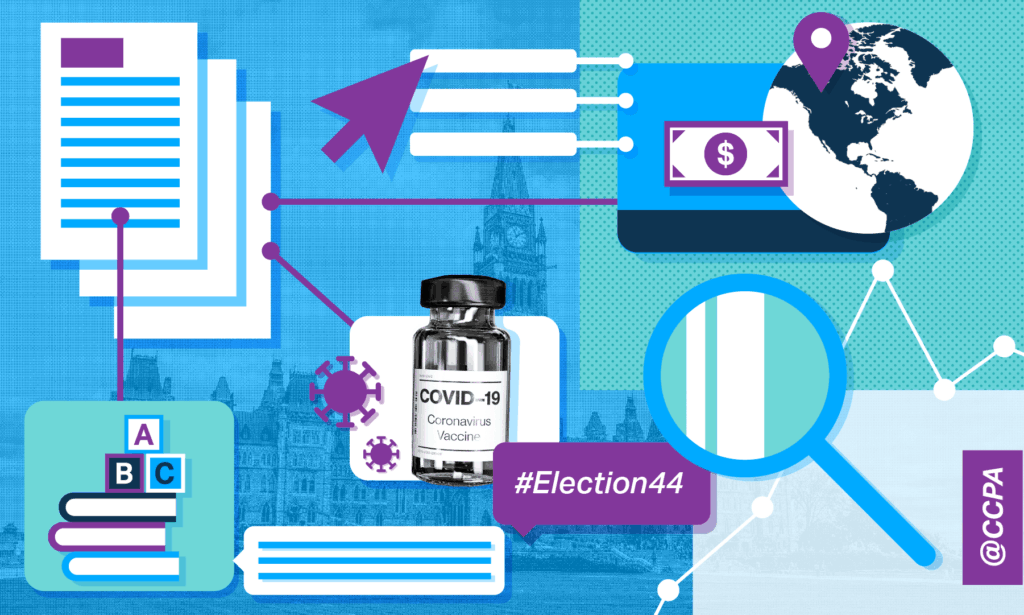With speculation that a federal election is imminent, the NDP has released a 115-page list of commitments and the Conservatives have dropped a few platform announcements.
We’ll be providing non-partisan analysis as the parties release their political promises, beginning with an overview of some of the NDP commitments, since it’s first out of the gate.
It’s unusual for a political party to release its commitments ahead of an election call. In recent elections, some parties haven’t even bothered to release a full platform. Perhaps the NDP is attempting to frame what this election should be about. Its commitments include, among other things:
COVID-19 response items;
Care economy items, such as a national child care plan, pharmacare, and dental care programs;
Climate emergency response, starting with a cabinet committee;
Affordability issues, such as housing, high-speed internet and cell phone service, as well as targeted student debt forgiveness;
A national action plan for reconciliation with Indigenous peoples, to which the NDP devotes considerable space in its 115-page document.
While it’s a wide-ranging document covering a gamut of issues—from working toward abolishing the Senate to lowering the voting age to 16—the NDP hasn’t released its cost estimates and, in some areas, it hasn’t revealed details about how it might implement certain promises. These might unfold during the course of the expected election.
COVID-19 response
All governments were caught unprepared for the COVID-19 pandemic, so we expect that all parties will weigh in on their crisis response commitments. For its part, the NDP is promising to establish a crown corporation charged with domestic vaccine production, to maintain an adequate personal protective equipment stockpile (including support for domestic production), and more support for the Public Health Agency of Canada.
In contrast, the Conservatives announced a pledge earlier this summer to implement a new Canada Emergency Preparedness Plan, which would include partnering with pharmaceutical companies to increase domestic manufacturing of medicines and vaccines, addressing supply chain issues, and overhauling Canada’s emergency stockpile system.
Since February, Ottawa has announced agreements with two vaccine manufacturers, U.S.-based Novavax and Moderna, to produce COVID-19 and mRNA vaccines in Canadian facilities.
Care economy
We can expect to see dueling pitches on the policies best suited to delivering meaningful support to women and families who were devastated after a year of relentless turmoil. Low-income, racialized and marginalized women, in particular, have bore the brunt of economic losses and continue to wait for September to roll around, hoping that their children will be safe in schools as the fourth COVID-19 wave takes hold.
For its part, the NDP is promising to deliver affordable child care for all families, to help support women’s employment and spur the economic recovery. In the short term, it will extend support to not-for-profit centres at risk of closure to preserve the supply of valuable child care spaces. It is a safe guess that the NDP will not be ripping up the new child care agreements being negotiated this summer by the sitting government.
In contrast, the Conservatives have not yet released a child care plank of their platform, but their leader recently told the P.E.I. Guardian newspaper that the plan would “try to give as much flexibility as possible for families.” If past CPC platforms are any guide, proposals may well focus on "cash for care" programs and boosting the private market in care services.
The NDP is also promising to make parental leave more flexible for eligible families (allowing parents to take shorter leaves at a higher replacement rate) and for self-employed parents wishing to opt into the system before the birth of a child.
As part of its Employment Insurance (EI) reform plans, the NDP will make EI available to people who quit their jobs to go back to school, to provide necessary child care, or to protect their health or the health of immunocompromised family members. Like the current suite of emergency benefits, this proposal adopts a more expansive approach to caregiving.
Experts agree that national standards on quality care are essential to rebuilding Canada’s grievously flawed long-term care system.
In terms of health care promises, the NDP commits to tackle wait times and improve access to primary care—a commitment that is a constant for many parties during an election but this time, due to COVID-19, there is a longer than usual backlog for many procedures and surgeries. We’ll say this of all parties: it’s going to take a major federal funding commitment to make this promise a reality, and it’s worth it.
The commitments document is not very precise on the crucial question of long-term care reform. It promises to work with stakeholders to develop national care standards for home care and long-term care and to provide the resources needed to enforce them. This, along with several other programs, is designed to support seniors—including a national pharmacare plan, more supported housing, pension protections and the full restoration of home-to-home mail delivery.
Experts agree that national standards on quality care are essential to rebuilding Canada’s grievously flawed long-term care system (see our report). So, too, is improving conditions of employment and the wages of care workers, which are grossly inadequate across the care economy. These services are mostly provincial but the federal government can, and should, set the bar. The NDP is proposing to extend pro-rated benefits to part-time and contract workers, and enforce “tough and pro-active” pay equity “right away”.
Climate emergency
The NDP commitments document addresses the climate crisis that is so evidently on our doorstep. It sets a more aggressive emissions reduction target of 50% below 2005 levels by 2030, including a commitment to the proven approach of carbon budgeting, while promising significant public investment into clean energy, energy efficiency and low-carbon, climate-resilient infrastructure.
How much investment? The platform doesn’t say. To fully and aggressively decarbonize the Canadian economy, it will require tens of billions of dollars in public money every year, especially in the early years, when long-term investments will make the biggest difference.
There are a number of interesting and novel ideas in the document—at least for Canadian politics—that could potentially differentiate the NDP from other parties. The NDP proposes a Canadian Climate Bank to finance the green economy while creating a Civilian Climate Corps to hire young workers for in-demand green jobs. An Office of Environmental Justice would lead the charge to address environmental racism and advance the idea of a just transition.
Where the platform most obviously comes up short is on oil and gas production. A commitment to phase out fossil fuel subsidies is welcome, but the NDP commits neither to stopping new oil and gas projects nor setting an end date for the extraction and processing of fossil fuels. There is no place for oil, gas and coal in our zero-carbon future. The question in this election is: will any party name this elephant in the room?
Affordability and accessibility
Affordability is a perennial NDP plank. Aside from child care, housing is one of the biggest expenses that a household faces.
Housing: The NDP promises to, among other things, create at least 500,000 units of quality, affordable housing over the next 10 years and fully fund an Indigenous National Housing Strategy. Given the prominence of affordable housing as an issue, we’ll be watching for more specifics on this file and whether other political parties will step up to create more affordable housing, including rental units.
Child care: That second big household expense, child care, gets covered in the NDP’s promise of a universal $10-a-day child care system—something the governing Liberals have already begun to negotiate with a number of provinces.
Tuition: For post-secondary students, the NDP is promising a targeted program to forgive up to $20,000 in student debt, remove interest from federal student loans, and move toward non-repayable grants. This promise could possibly differentiate the NDP or condition the field for other parties to follow suit.
Transit: The NDP is also committing to help provinces and municipalities “build towards fare-free transit” and to replace Greyhound bus routes with “a public inter-city bus system.” Given the need, it will be interesting to see if other parties go here too or if the best they can do is offer high-speed rail between the Quebec-Windsor corridor, which seems to get trotted out at election time but never delivered on. For its part, the NDP is promising “high-frequency rail” along that corridor and expanding rail options in other regions.
Telecommunications: Making high-speed broadband available everywhere by 2025, not 2030 as the federal government currently plans, is a step that recognizes the essential role of the internet in Canadians’ lives and the Canadian economy, and the significant gaps that currently exist. The Conservatives have promised to meet this target by 2025 as well. The idea of a telecom Crown corporation, as included in the NDP commitments document, could address a key issue: Right now, the federal government and the provinces generally expand broadband by giving money to private corporations that then own the assets we helped them pay for. Why not just have our own company and own the assets ourselves? A new Crown corporation could (hopefully) be a first step towards nationalizing the broadband network (see this article to read why this is recommended policy). That said, the commitments document makes no mention of the Canadian Radio-television and Telecommunications Commission (CRTC), which has attracted widespread criticism for its evident desire to serve corporations rather than consumers. A serious overhaul of the CRTC is due.
Income supports
A guaranteed livable income: The idea of a basic income has grown more traction in recent years. The NDP’s answer is to promise a guaranteed livable income, starting by lifting seniors and people with disabilities out of poverty. This basic income proposal, like many others, is aspirational in intent but thin on details.
Security reform: The document sets out several income security reforms designed to tackle some of the holes in Canada’s current safety net, which were blown wide open by the pandemic. This includes setting a new floor for EI benefits of $2,000/month and extending the Canada Recovery Sickness Benefit until such time as a permanent “safety net of paid sick leave across the country” can be established.
Other anti-poverty measures: New investments in affordable and supported housing, universal child care and food security round out its list of top anti-poverty priorities—all essential to ensuring that people caught on the wrong side of the pandemic are not left further behind.
How we pay for it
The NDP has a lot to say about making Canada’s tax system more progressive, including taxes that we normally put forward in our annual Alternative Federal Budget:
Increasing the capital gains inclusion rate to 75%;
Adding an additional 15% tax on large corporate windfall profits during COVID-19;
Boosting the top marginal tax rate by two points;
Creating a 1% wealth tax;
Returning the corporate income tax to 2010 levels.
Some parts of the plan need to be further detailed, including how much revenue the proposals are expected to generate.
At the CCPA, we’ve long said that taxes are the gift that keeps on giving—because they pay for vital public services and income supports. Increasing taxes for the highest-income Canadians has proven popular in public opinion polling but political parties often shy away from this conversation. We’ll be watching to see which party, if any, the NDP sparks a debate with on this front.
The CCPA has done extensive research and analysis on a wide range of federal policy issues, most notably through our annual Alternative Federal Budget. As we head toward a federal election, we’ll be sharing our independent, non-partisan analysis and fact-checking of campaign promises and platforms from all the major parties as they are released.















